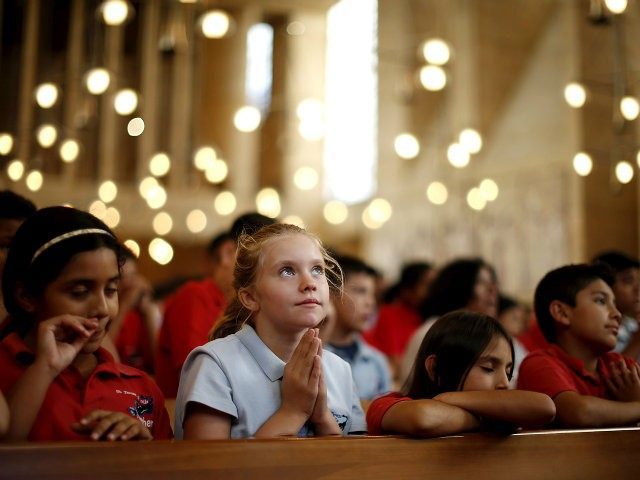The U.S. Supreme Court determined in Espinoza v. Montana Department of Revenue on Tuesday that restricting public scholarships from being used to pay religious school tuition was a violation of the First Amendment freedom of religion.
Curiously, four of the five justices in the majority — all of them Republican appointees — authored their own opinions.
Chief Justice John Roberts, who had sided with the Court’s liberal minority on social issues in every decision handed down thus far this month, wrote the main opinion for the majority. He noted that the Montana constitution included a “no-aid” provision “which prohibits any aid to a school controlled by a “church, sect, or denomination.” The Montana Supreme Court invalidated the entire scholarship program because it did not have a way to prevent funds from being used at religious schools.
Roberts said that the program did not violate the First Amendment: “We have repeatedly held that the Establishment Clause is not offended when religious observers and organizations benefit from neutral government programs,” he wrote.
He added that the Supreme Court accepted the Montana court’s finding that the program was a violation of the state constitution. The question, Roberts said, was whether the state constitution’s “no-aid” provision was itself a violation of the U.S. Constitution when it was applied to scholarships that were spent at religious institutions.
The answer, he said, was yes, because “Montana’s no-aid provision bars religious schools from public benefits solely because of the religious character of the schools.” That was a form of religious discrimination, even if it did not single out a particular religion. The fact that the schools would provide religious instruction was not relevant, he argued, because the form of discrimination in this case was solely based on the religious “status” of the schools in question.
Moreover, he said, the fact that the Montana Supreme Court struck down the entire scholarship program did not cure the problem, because the Montana Supreme Court never should have applied the state constitution to the program at all.
Justice Clarence Thomas wrote a separate, concurring opinion “to explain how this Court’s interpretation of the Establishment Clause continues to hamper free exercise rights. … Properly understood, the Establishment Clause does not prohibit States from favoring religion. They can legislate as they wish, subject only to the limitations in the State and Federal Constitutions.”
He added:
Under a proper understanding of the Es- tablishment Clause, robust and lively debate about the role of religion in government is permitted, even encouraged, at the state and local level. The Court’s distorted view of the Establishment Clause, however, removes the entire subject of religion from the realm of permissible governmental ac- tivity, instead mandating strict separation.
This interpretation of the Establishment Clause operates as a type of content-based restriction on the government. … It communicates a message that religion is dangerous and in need of policing, which in turn has the effect of tilting society in favor of devaluing religion.
Justice Samuel Alito wrote a concurring opinion in which he provided some historical perspective on the origins of state restrictions on religious institutions, which he traced to anti-Catholic sentiment in the 19th century (footnotes omitted):
A wave of immigration in the mid-19th century, spurred in part by potato blights in Ireland and Germany, significantly increased this country’s Catholic population. Nativist fears increased with it. An entire political party, the Know Nothings, formed in the 1850s “to decrease the political influence of immigrants and Catholics,” gaining hundreds of seats in Federal and State Government.
Alito’s opinion even included an editorial cartoon depicting Catholic priests as crocodiles:
Justice Alito’s opinion is long on history of anti-Catholic bias that was behind states enacting constitutional amendments that barred aid to religious entities. It includes this 19th C cartoon from Harpers showing Catholic priests as crocodiles pic.twitter.com/XJ858pujm9
— Lawrence Hurley (@lawrencehurley) June 30, 2020
He adds that “Catholic and Jewish schools sprang up because the common schools were not neutral on matters of religion,” and enforced a particular Protestant viewpoint — not a general secular worldview.
Justice Neil Gorsuch added his own concurring opinion, noting that the notion of discrimination based on religious “status” did not necessarily go far enough in describing the controversy. “Maybe it’s possible to describe what happened here as stattus-based discrimination. But it seems equally, and maybe more, natural to say that the State’s discrimination focused on what religious parents and schools do—teach religion” (original emphasis).
The Constitution, he said, protected religious conduct, not just religious status. “What benefits the government decides to give, whether meager or munificent, it must give without discrimination against religious conduct,” he concluded. Therefore the Montana Supreme Court was wrong — not just because it was discriminating against religious schools as such, but because the Constitution allowed, and protected, using a public benefit for the exercise of religion itself.
Joel B. Pollak is Senior Editor-at-Large at Breitbart News and the host of Breitbart News Sunday on Sirius XM Patriot on Sunday evenings from 7 p.m. to 10 p.m. ET (4 p.m. to 7 p.m. PT). His new book, RED NOVEMBER, is available for pre-order. He is a winner of the 2018 Robert Novak Journalism Alumni Fellowship. Follow him on Twitter at @joelpollak.

COMMENTS
Please let us know if you're having issues with commenting.